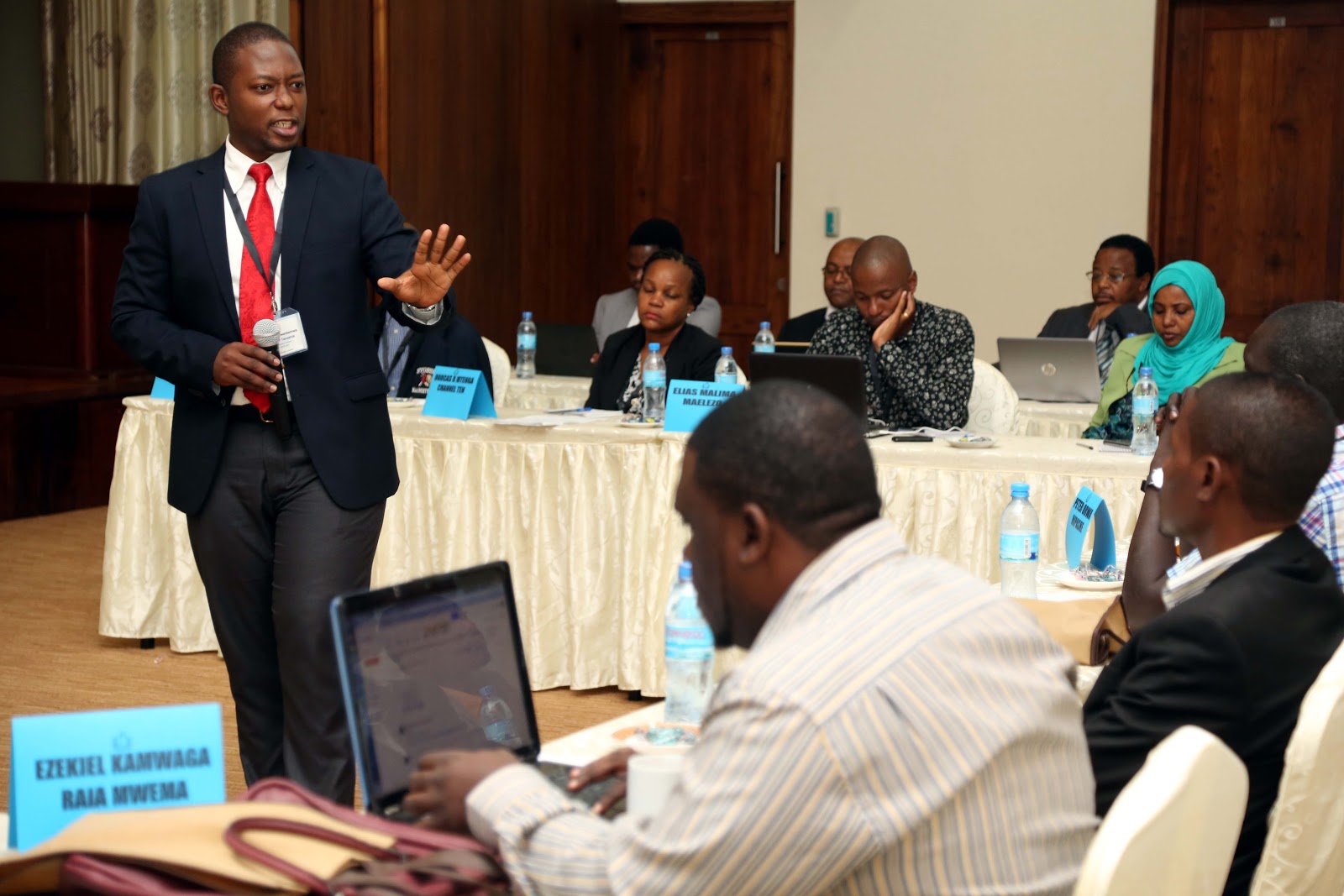Effects of the debt burden will be minimal in the short term because many of Tanzania’s debts have long periods of maturation.
A large portion of the Tanzania debt is payable under ‘long term maturity’ agreements, with the average time to maturity set at 11.9 years. This means effects of debt repayment on the government budget is ‘low refinance risk’.

BoT Economist Lusajo Mwankemwa from the Department of Research and Economic Policy (Left)
talks to business reporters in Zanzibar. PHOTO CREDIT: K-VIS BLOG.
By Jaston Binala.
Total Government debt in Tanzania which currently stands at a staggering USD 19 billion is conveniently manageable and repayable, according to economic data made available to reporters during a workshop in Zanzibar.
The ‘debt stock’ representing domestic and external national debt is payable from goods and services produced in Tanzania– and there is room for additional borrowing, according to the availed data.
Lusajo Mwankemwa, an economic analyst from the Department of Research and Economic Policy at the Bank of Tanzania told reporters in Zanzibar in late March, 2017 the nation’s current ratio of Total Government Debt to Gross Domestic Product (GDP) stands at 34.2%, which compares to the acceptable ratio cap at 56%.
A low Government Debt-to-GDP ratio suggests the economy has capacity to produce and sell goods and services at sufficient levels to repay all national debt without incurring additional debt, according to analysts.
Mwankemwa presented data which shows the ”Present Value of External Debt to GDP” was 19.9%, marginally less than half the cap at 40%. The ratio of external debt to national exports was 97.7% againsts its cap at 150%. The figures also show the current ratio of the value of external debt to domestic revenue was 145.3% against its cap at 250%.
“Basing judgment on these benchmarks Tanzania is in a position to continue borrowing from both external and internal sources to finance development projects,” Mwankemwa said. “The country has the capacity to repay maturing debts using domestic revenue and external sources.”

Journalists attending the Bank of Tanzania workshop in Zanzibar. All Pictures courtesy of K-VIS BLOG
Bank of Tanzania analysis conducted in late 2016 revealed matured external debt repayment using domestic revenue had reached 11.5% against the desired 20%. External debt repayment using exports was found to stand at 7.8% against the desired level at 20%.
The fourth phase government under Jakaya Mrisho Kikwete handed over the Tanzania economy suffering a 6.5% inflation rate in late 2015. By September, 2016 however, almost one year into the fifth phase government, inflation had been pushed down to 4.5% through monetary instruments to mop up excess liquidity.
Drought in the entire East African region has forced food inflation upwards with Tanzania experiencing an upward jerk to 5%, but this is still lower than 6.5% in 2015.
Alfred Mwenisongole, a retired lecturer in economic theory at Mbeya Labor College, finds the current economic circumstances to define a resilient and stable economy set to encourage both local and foreign investment.
“A single-digit inflation rate of 5% assures both workers and employers wages will be worth something. It is possible to plan personal development with a stable inflation rate,” Mwenisongole said. “A sense of confidence in the value of earnings leads into a healthy consumer behavior which assures investors of a market for products in the economy.”
The data given to business reporters in Zanzibar during a week-long workshop in late March, 2017 portrays a resilient economy the analyst in Dar es Salaam, Alfred Mwenisongole, has described as very attractive to both local and foreign investors.
Talking exclusively to this website on the sidelines of the workshop in Zanzibar, the central bank economist said there is a slight difference between the fourth and the fifth phase Tanzania governments.
The fourth phase government was more fixated on recurrent expenditures which carried the threat of increasing cash in the economy–which could easily result in higher inflation. The central bank instituted a tight monetary policy throughout the forth-phase government as a measure to tame the leadership’s expansionary fiscal regime.
The fifth phase government is focused on infrastructural development budgeting which by its nature might squeeze money supply. This is one of reasons the Bank of Tanzania has relaxed money supply, he said. In early March 2017, BoT reduced the discount rate from 16 down to 12 percent. Three weeks later, the central bank lowered the commercial banks’ Statutory Minimum Reserves (SMR) rate from 10 per cent down to 8 per cent which aimed at increasing money supply in the economy.
HARMLESS DEBT BURDEN
It is in the meantime the view of the Bank of Tanzania that effects of the debt burden will be minimal in the short term because many of Tanzania’s debts have long periods of maturation.
The ‘debt stock’ increased from USD 18.459 billion in June, 2016 to USD 19.0219 billion in December 2016. Central Bank data explains this increase as resulting from infrastructural loans for use in constructions of the Tanzania-Zambia Railway (TAZARA), the Jakaya Kikwete bridge on Malagarasi river, construction of the Morogoro – Dodoma road, Dodoma – Singida – Arusha road, the Mwanza – Bukoba road and the Lake Victoria water project.
The loans are also intended to finance the Mtwara – Dar es Salaam gas pipeline, the Dodoma – Singida – Mwanza road, the Kinyerezi I & II power projects and the so-called national backbone communications system.
The Tanzania Minister of Finance and Planning Dr. Philip Mpango has unveiled the Tanzania fiscal 2017/18 budget proposal in which the government plans to spend Tsh 31.6tri/-, denoting an increase of 2.2tri/- above the 2016/17 budget of Tsh 29.5tri/-.
The Minister has told Parliament in Dodoma in central Tanzana the proposed budget is in line with the National Development Plan for 2017/2018 in which a budget allocation totaling 19.7tri/- will be directed toward recurrent expenditure where the wage bill is planned to carry Tsh. 7.2tri/- while Tsh 9.4tri/- will be used to finance debt. Tsh 11.9tri/- is set aside for development projects.
Projects lined up for implementation include completion of the Muhimbili University of Health and Allied Sciences — Mloganzila Campus and upgrading the central ailway line to Standard Gauge level. Other projects on the cards include revival of the state airline Air Tanzania Company Limited, implementation of the Liganga iron ore and Mchuchuma Coal projects.
The identified additional priority areas include establishing special economic zones in various regions such as Tanga, Coast Region, Kigoma, Ruvuma, and Mtwara, implementation of Liquefied Natural Gas project and investments in two sugar factories. Plans are also underwy to revive Arusha General Tyre, implementing the Soda Ash project in Engaruka Valley and strengthening of the National Empowerment Development Fund. The Minister also noted the government will push implementation of its plan to relocate to Dodoma.
Mwankemwa said repayment of the stock of debt does not consider the size of the debt, but the maturation of the debt.
Under existing circumstances, the central bank economist said, a large portion of the Tanzania debt is payable under ‘long term maturty’ agreements, the average time to maturity set at 11.9 years. This means effects of debt repayment on the government budget is ‘low refinance risk’.




